There comes a time in every person’s life when he just wants to be on the top of the world. He wants to feel what it’s like to be at the top where the rays of light for the Sun fall first. That feeling of being at the top is just amazing. Every man craves it. It’s in our nature.
In this time, a man wants to do something far more daring, something dangerous, something, which involves some kind of risk, something that he would do only once in a blue moon, but gives it all and in the end…emerge as a conqueror. If you are reading this, then you are probably one of them.
You are probably bored with your normal routine. Even your normal hikes, although fun, just don’t give you enough joy. Because you are looking for more. You want to climb high, you want to test your fear of failing, or defeat it. You want to get to the top. And you want to be above the clouds where the world looks so tiny you can just grasp it in your hand.
Welcome to the world of mountain climbing then. This is the world where you would find the lost joys of adventure in your life. Although there are lots of peaks in the world that are worth mentioning, they require some professional level experience like the Himalayas. Most people are not looking for that. They just want to climb a mountain which is relatively easy (there is a reason “climbing a mountain” is an idiom for hardship) just so they can level up their game. Plus some people also don’t have either money or time to travel around the world.
So these are the top 10 best mountains to climb in the US where you can hike and climb for big adventure:
1. Mount Rainier
- Location: Washington
- Elevation: 14,411 ft.
- Difficulty: Hard 8/10
- Best time to climb: July and August
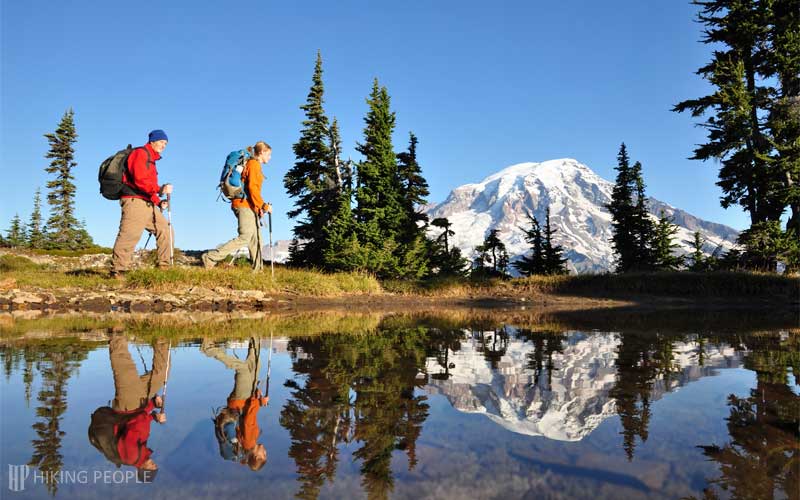
Mount Rainier is the tallest mountain in the Cascade Range. The 14,411 feet high mountain can be seen from Seattle and is one of the most well-known peaks in America. It is the fifth highest mountain in the US with thousands of attempts each year towards its beautiful glacier cap. The most prominent feature of Rainier is the 13,000 feet vertical relief which is larger than many of the tallest mountains and this makes Mount Rainier, not an easy mountain to climb.
Among the three classified summits of Mount Rainier, Liberty Cap, Point Success and Columbia Crest (highest at 14,411 feet), experienced hikers most commonly choose Disappointment Cleaver and Emmons Glacier to reach the top of these summits. The climb is extremely difficult at the Ingraham Glacier Direct Route as it crosses the largest glaciers in the US outside Alaska. From the summit, you can see as far as Portland, Oregon.
2. Mount Katahdin
- Location: Northeast Piscataquis, Maine
- Elevation: 5,269 ft.
- Difficulty: Moderate 5/10
- Best time to climb: Mid July
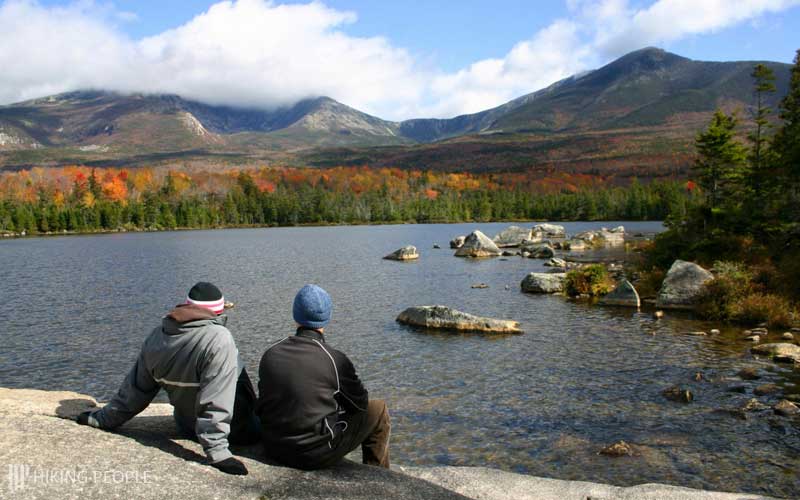
The highest peak of the Baxter State Park, Maine, stands at 5,269, Mount Katahdin. The peak provides a great view of the Maine backcountry standing almost a mile above sea level at the Appalachian Trail. The trail to the summit comes across the famous “Knife Edge” trail which is only two feet wide at some places surrounded by thousand foot drops at either side providing hikers with a unique experience.
The blade-like arch connecting Katahdin’s highest summits is the most attractive feature of Katahdin and it is a sort of a challenge that every hiker looks forward to uptake with excitement. The best way to reach the summit is through the Chimney Pond. A compound from where you can see 2000 feet above along with the hikers crossing the Knife’s Edge. However, hikers should start early if they want to hike such a spectacle for there are a limited people allowed in the Baxter State Park daily.
3. Longs Peak
- Location: Colorado
- Elevation: 14,295 ft.
- Difficulty: Moderate to Hard 6/10
- Best time to climb: Mid July
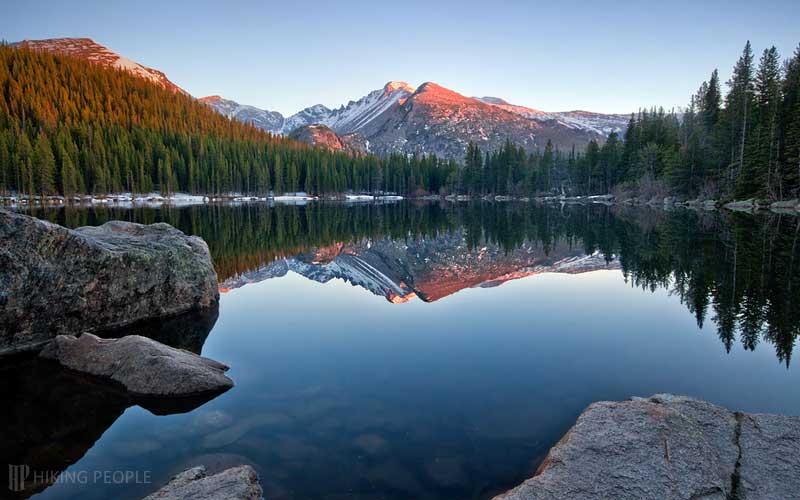
In the North of the Rocky Mountain National Park stands one of the most famous peaks of America with a height of 14,295 feet, the Longs Peak. It is among the 54 longest peaks in Colorado and one of the most difficult mountains to climb.
The famous Keyhole route of the Longs Peak is non-technical in the summer season which runs through mid of July till the early September but nevertheless is physically challenging and provides ample exposure making it on the list of adventure travelers. The Keyhole route is open in other seasons but it is classified as a technical climb due to ice formation and snow, requiring specialized climbing equipment.
Hikers are advised to start their journey as early as 3 AM and reach the summit and come down before afternoon due to the frequent afternoon thunderstorms which pose a threat of the lightning strike. For climbers who do not want to go for the summit, there are other popular destinations like the Peacock Pool and Chasm view.
4. Pikes Peak
- Location: Colorado
- Elevation: 14,110 ft.
- Difficulty: Moderate 5/10
- Best time to climb: Summer
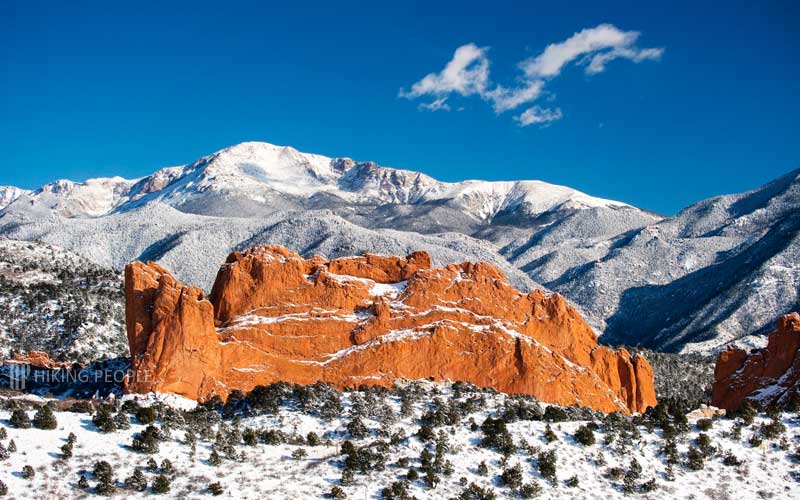
The Pikes Peak is the tallest mountain in the southern frontier of the Rocky Mountain National Park and is among the 54 longest peaks in Colorado rising above 14,000 feet. It is also labeled as a National Historic Landmark.
Even though it is among the tough mountains to climb in the US, the amazing thing about Pikes Peak is that there are a number of ways to reach the summit. You can hike, take a bicycle or even a car making it all the easier. The Barr Trail is the most famous hiking trail of the mountain which extends 13 miles. Hikers usually take 2 days to reach the summit making a stay at a base camp because covering the 8000 feet elevation in one day would be no less than a marathon.
Reaching the summit, you will be a bit surprised to find a gift shop and a snack stall along with many tourists who would have reached there by car. And if after reaching the summit, you don’t feel like coming down on your feet, then you can grab a shuttle as well. The Pikes Peak is climbable in any season other than winter but beware of afternoon thunderstorms in the summer.
5. Mount Hood
- Location: Oregon
- Elevation: 11,249 ft.
- Difficulty: Moderate to Hard 7/10
- Best time to climb: Late June
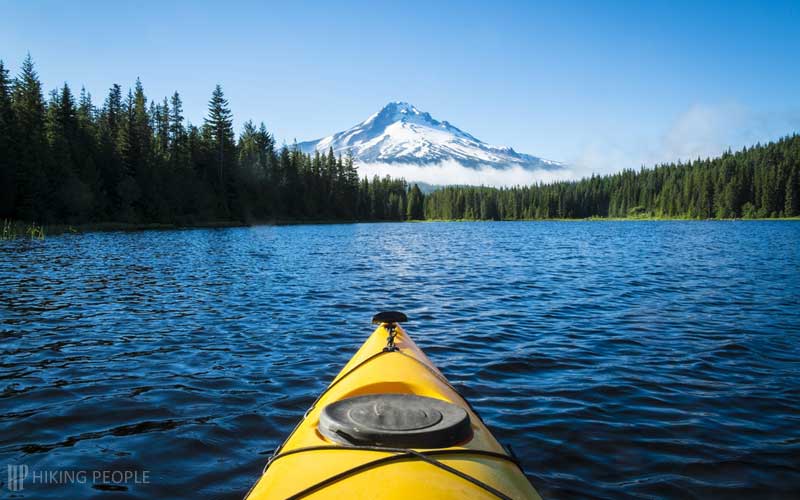
50 miles east-southeast of Portland, is the tallest peak of Oregon standing at 11,249 feet above the sea level providing an excellent training ground for mountain climbing and the most climbed glaciated peak, is the iconic Mount Hood. Mount Hood provides a great learning opportunity for mountaineers who are new to snow climbing and want to learn to climb the icy surfaces and other advanced skills.
The most common summit route, the South Side route is a half day climb and is guided from late April June every year. What makes Mount Hood a great peak is the low altitude and being relatively less technical letting beginner mountaineers get a hang of skills like route finding, crevasse rescue and experiencing the icy surfaces like stopping yourself in case you lose footing.
That being said, it does not mean that you take Mount Hood lightly. You will find yourself at odds with the weather with frequent rock falls and so it is recommended that you keep an ice axe, crampons and always wear a helmet.
6. Mount Whitney
- Location: California
- Elevation: 14,494 ft.
- Difficulty: Hard 7/10
- Best time to climb: July to September
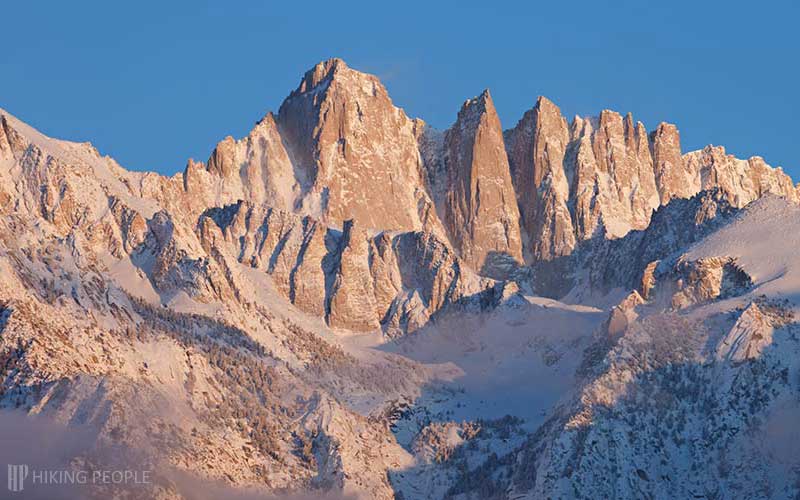
Mount Whitney is the highest peak in the lower 48 and is situated in the Sierra Nevada Range of Central California. Famous among climbers for the view of the snowy range, but don’t be fooled by the fame, for it is not a piece of cake. Climbers often need crampons and an ice axe to reach to the summit.
However, the weather is warm enough between July and October to avoid technical climbing. The trail starts at the Whitney Portal on the east of Sierra Crest 13 miles west to Lone Pine where you will go for almost 11 miles to climb 6000 feet to the summit.
Experienced climbers prefer the Mountaineer’s Route which is a class 3 climb up north or the more challenging east face.
7. Mount Washington
- Location: Sargent’s Purchase, New Hampshire
- Elevation: 6,288 ft.
- Difficulty: Moderate 5/10
- Best time to climb: July to September

Mount Washington is the highest summit in the northeastern U.S and is most prominent in the east of the Mississippi River and is located in the Presidential Range of the White Mountains providing a beautiful, clear view of the surrounding.
What makes Mount Washington an attraction for the adventure lovers is its unpredictably horrible weather. On April 12, 1934, the Mount Washington Observatory recorded a wind speed of 231 miles per hour, a world record for the highest wind speeds without a tropical cyclone.
But it’s not just the weather which makes it all the more challenging, it is also the climb that is challenging as well. The ascent from the South gully requires an ice axe, crampons, ropes, and some serious mountaineering skills. The most famous route is the Tuckerman Ravine Trail. However, the Appalachian Trail also crosses the summit. Hikers can take the shuttle service down from the visitor’s center at the top.
8. Mount Haleakala
- Location: Hawaii
- Elevation: 10,023 ft.
- Difficulty: Moderate to Hard 6/10
- Best time to climb: June to August
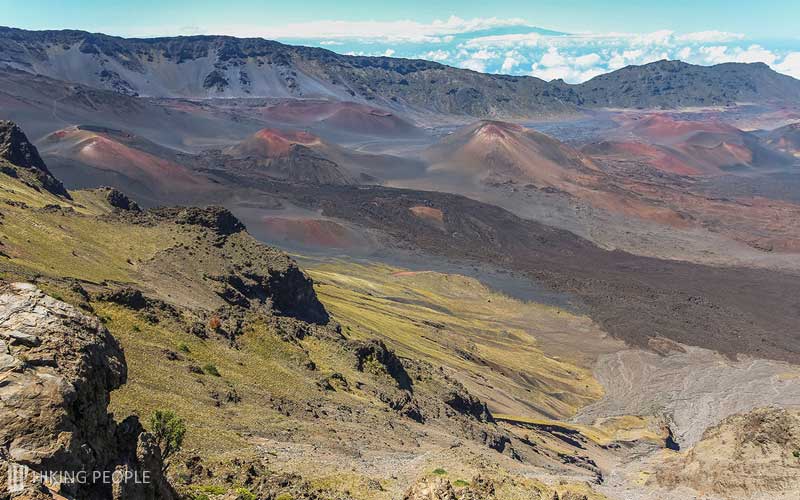
Mount Haleakala is one of the best places to explore the unique volcanic terrain of Hawaii. It forms 75% of the island of Maui. It is also considered sacred by the native people. Although the summit can be reached by road, hiking provides the best way to observe the unique and usual surface of this active volcano. The peak of Haleakala is also considered to be the best places on Earth to view the clear, beautiful sky at night.
Mount Haleakala is a part of the Haleakala National Park. It has numerous hiking trails and cycling guides in the park along with a well maintained two-lane highway and is a very famous tourist spot to watch the sunrise.
From the summit, the visitors look down into a crater that is almost 7 miles across, 2 miles wide and 2,600 feet wide.
9. Denali
- Location: Alaska
- Elevation: 20,310 ft.
- Difficulty: Very Hard 10/10
- Best time to climb: May & June
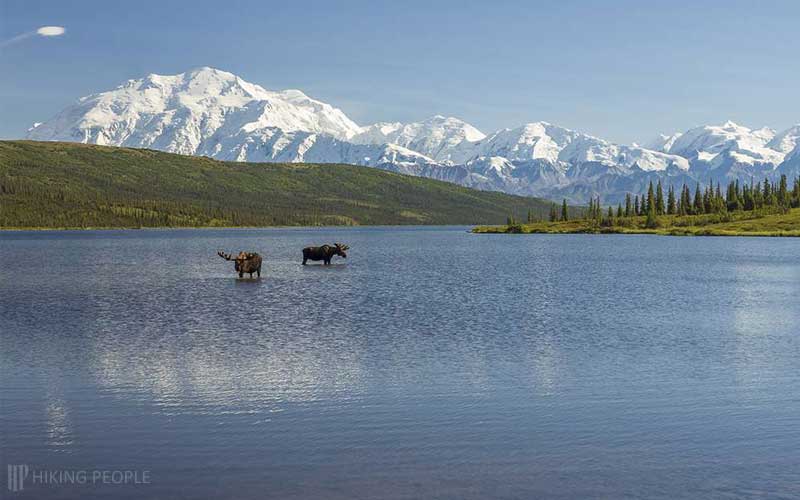
Denali, also known as Mount McKinley. It is the highest mountain in North America and the third most prominent peak on Earth, after Mount Everest and Aconcagua. It is situated in the interior of Alaska in the Alaska Range. And this is for serious mountaineers only who are looking for weeks long trip.
Denali has two summits, the North and the South summit. The South Summit is the highest and the North summit is slightly short at 19,470 feet. The North summit is rarely climbed.
The West Buttress Route is a non-technical climb that takes about three weeks. However complex weather pattern makes it difficult and exhaustion can trick you into making some fatal decisions. So it is recommended that when going on this trip, always be a part of a group along mountaineering guiding company who will help you prepare for it.
10. Mount St. Helens
- Location: Washington
- Elevation: 8,636 ft.
- Difficulty: Moderate 5/10
- Best time to climb: July to mid-September
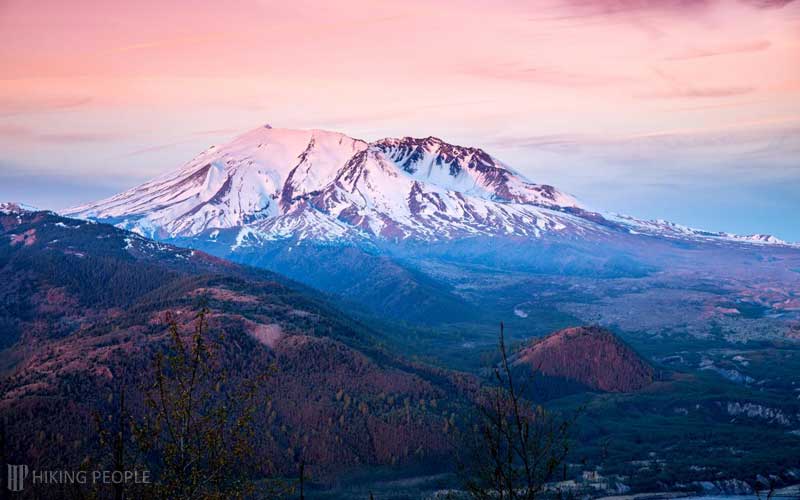
Mount St. Helens is notoriously known for its violent eruption in 1980 which is termed as economically the most devastating volcanic event in American history reducing the mountain’s summit from 9,677 feet to 8,363 feet and a mile wide horseshoe-shaped crater.
St. Helens is popular among both beginners and expert mountaineers. The peak is climbed throughout the year. A permit system is in place since 1987 and a permit is required to go beyond 4,800 feet. All routes to the peak contain steep terrain.
A famous route in the warm season is the Monitor Ridge Route. It gains 4,600 feet in about 5 miles to reach the rim and is the most crowded and popular route. It is considered a non-technical climb with some scrambling and can be completed in 7-12 hours.
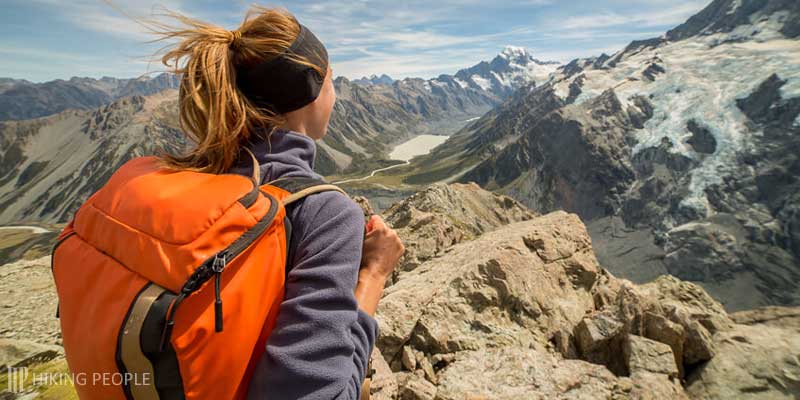
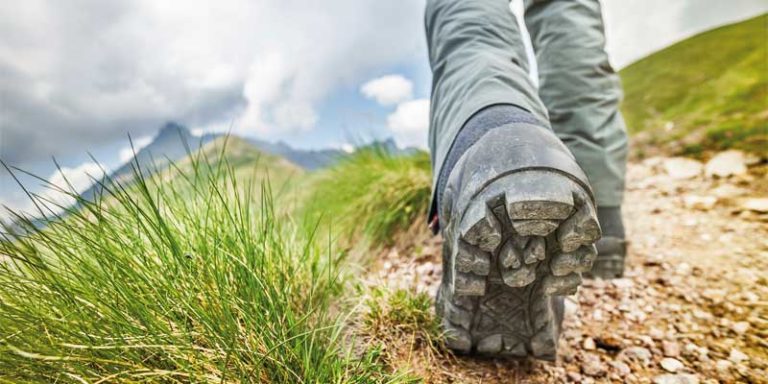
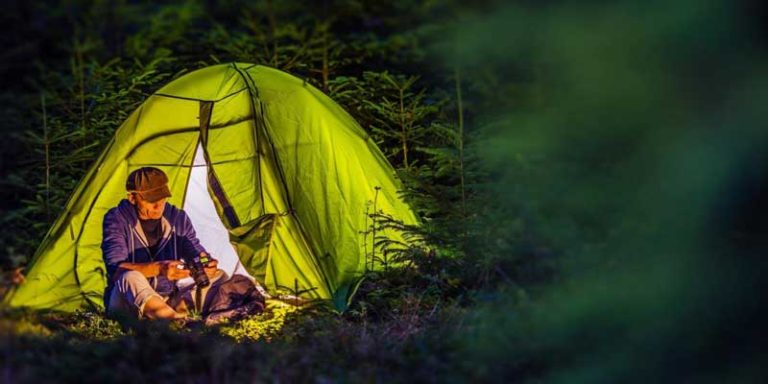
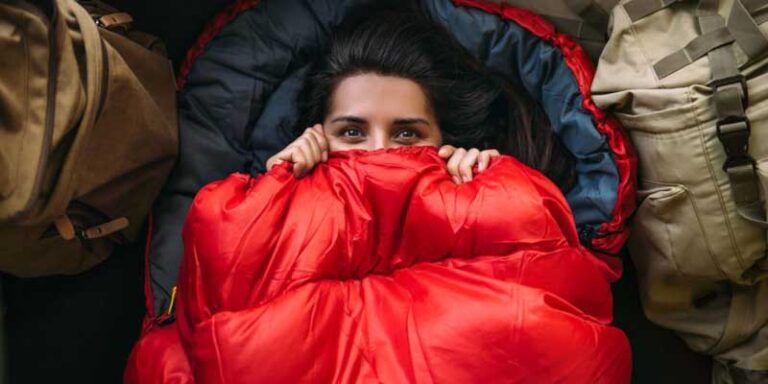
These mountains to climb in the US, provide beginner climber the best experience and acclimatization before travel abroad to climb highest Mountain in Africa, Kilimanjaro
Using “Mount Katahdin” is redundant . In the Penobscot language, the local Indigenous People, Katahdin means large or great hill. Please respect our sacred mountain and our language. It’s simply “KATAHDIN’.
Butch Phillips, Elder, Penobscot Nation.